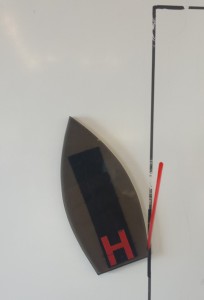We’ve all watched as they slink slowly and silently across the bay. Some of them are a few hundred feet long and others over 1,000 feet and for the most part small boaters stay out of the way. Some never give them a thought; others are curious about what is happening on the bridge, where they came from and where they are going. Maybe a few of us wish we could be aboard. By now you have surmised that I’m talking about the ships that decorate the San Francisco bay.
A dream came true for me recently as I was given the opportunity to observe the San Francisco Bar Pilots in operation. The assignment was to meet the Bar Pilot at 0600 at pier 58 in Oakland for a 0730 departure. The trip from Oakland 58 would take us out to the pilot boat approximately 10 miles off shore. Climb the ladder down to the pilot vessel and wait for another ship that would arrive at the sea buoy at 1430 and ride it back into Oakland 58. Waiting on the event to take place, I was like a kid anticipating the arrival of Christmas.
Before going further I must thank everyone involved with helping set this up and this includes personnel at the USCG Regional Exam Center in Oakland, CA as well as the San Francisco Bar Pilots and staff involved. A special thanks to pilots Captain John Carlier and Captain David Pate. This trip was related to my USCG Auxiliary duties at the Regional Exam Center [REC].
My work at the REC had given me an insight on the experience and knowledge required to be accepted to the Bar Pilot training program. I had an appreciation for their skills and professionalism that had been previously observed. However, I must admit that I was blown away with the courtesy they gave me, the professionalism I saw firsthand, the ever real and present dangers they accept as just part of the job.
Greetings were exchanged in the parking lot of Oakland 58 and port security gave the pilot and me a ride to the ship. Pulling alongside the MSC Vittoria, a 1065 feet container ship, we departed the van and the action started. The pilot quickly ascended the ships ladder to the first deck. As soon as his foot hit the deck one of the mates radioed the bridge “pilots aboard” and we moved almost at a run through sections of the ship to an elevator that was the size of a phone booth. The pilot, mate and I squeezed into the elevator and were lifted to the 5th floor [deck]. Down a hallway and up two flights of stairs and entered the bridge where the captain immediately greeted the pilot. The pilot explained my presence.
My first impressions were that there was no chitchat, very friendly but professional, and the bridge was spotless clean. The captain welcomed us aboard and offered to provide us water, coffee, or tea. We passed on his offer and then the pilot and captain began a pre departure dialog and exchanged paperwork. My other impression was the cleanliness of the bridge area. Boarding the ship we moved so quickly I never had time to look around but now the pace for me slowed and I had time to observe my surroundings; there was not a smudge anywhere on a window, no marks on the floor, no dust anywhere. Looking at the massive control panels they were spotless.
From the time we arrived on the bridge the helms person was at the helm waiting on orders. The helm for the ship is the size on my Subaru Outback, about 18 inches in diameter.
The pilot set up his navigational instrument and walked out on the wing overlooking the water. Picking up his radio called the tugs [Sandra Hugh and Revolution] on channel 13 and advised them that the working channel would be 11 and asked them to connect up to specific positions on the ship. He then switched channels to the Vessel Traffic Service, channel 14, and advised that the MSC Vittoria was preparing at Oakland 58, turning at Schnitzer’s, intending to take the Delta Echo span of the bay bridge and west bound after departure. Traffic acknowledged his transmission and advised that our traffic was a tug and barge operating in the area of the bridge.
The pilot asked the captain if the bow thruster was operational and could it be operated at 100 % power. An assurance was given by the captain that it and all equipment was completely functional. The pilot asked the tugs to start pulling at specific power settings and he slowly increased the speed of the bow thruster. Very slowly we inched off the dock and the ship slid out from under the massive cranes on the.
When the pilot was satisfied with our position in the channel, Oakland Estuary, he requested the helm amid ship and dead slow ahead and immediately the pitch of the engine noise changed and the mate responded with “dead slow ahead”. The helmsman responded “rudder amid ship”. Each command by the pilot is repeated by the person receiving the request and repeated again when completed. The pilot thanks them after each acknowledgement.
MSC Vittoria was now heading up the estuary toward Jack London square as it was port side to the dock. This means it will go to an area known as Schnitzer’s turning basin. As we enter the area there were tugs and ships moored on either side of the area that reduces the operational area. The ship is 1065 feet long and the turning basin not wide enough for the ship to make a perfect 360 degree turn so as she comes around the pilot has to direct the tugs and helms person on repositioning the stern and bow to miss all obstacles. As the bow is almost around the bow lookout radios that it looks like we will hit a moored vessel and the captain relays this to the pilot. The captain advised that he thinks we will miss by “x” number of feet and the pilot agrees; however, the pilot gives orders that repositions the ship for extra clearance. The ship is now pointed down the channel and underway making way towards the bay bridge.
The pilot releases the tugs and thanks them for their outstanding work.
With a slight pause in the action I ask how much visibility is lost off the bow of the ship since she is loaded and how much effect does the wind have on him. He explains that he has a ¼ mile blind spot in front of the vessel and that wind has a large effect on the vessel. He goes on to explain that of course the tidal current has a huge effect on the ship but since the ships now days are so long and deep in the water [our draft was 42 feet] the ships act as a dam across the channel. Because the turning of the ship takes a while water pressure builds on one side of the ship and decreases on the other side because of the damming action. So all the time the vessel is turning he is using his experience and “mariner’s eye” to keep track of several visual ranges to make sure he is always in control. He also keeps a lookout for other traffic especially pleasure boaters that think they have room to pass in the tight areas.
He explained how they have practiced on the simulator at Cal Maritime Academy in Vallejo trying to determine the best method of making this turn and developing their skill set.
As the pilot navigates the Vittoria out of the Oakland Estuary toward the bay bridge a passenger ferry passes us on the port side and completely disappears into our blind spot for what seems to be minutes. The USCG cutter Hawksbill is also in-bound and overtaking us. The Hawksbill radios to the pilot their intentions to pass on our starboard side and the pilot radios back that he agrees with starboard side. [The Inland Navigational rules require intentions and agreement.]
Passing other container ships along the dock the pilot explains that until we clear the docks he will keep his speed below 5 knots because of suction from his ship would pull the other ships off the dock. As a ship passes through the water the water is displaced with the hull of the ship and when the ship passes the void is immediately filled in with the displaced water. On a fast moving ship this suction is enough to break the mooring lines of vessels.
Be extra careful when passing a ship in a narrow channel. While working for Vessel Assist I had a boat under tow and had to pass a ship in Redwood Creek. The pilot aboard radioed that he would slow as much possible for me but be careful as Redwood Creek is very narrow. As I approached the stern of the ship my vessel and the towed vessel started to be pulled towards the stern and the water level dropped by 3 feet on the bank as the void was filled.
At the entrance to the Oakland Estuary is ATON’s 7 and 8. The pilot radioed our position to the VTS and immediately ordered several degrees to starboard. With this maneuver it looked as if he was going to pass the east side of Yerba Buena Island; however, he explained with the flood tide we were going to be pushed hard to port and he was setting up for the current. Just as he said the current hit the boat and we started a slow turn to port that set him up to pass under the Delta Echo span of the bay bridge. Perfection is beautiful to watch. He explained how he was watching the center span of the bridge where it covered a point on the land and how if he kept this range in alignment he would pass comfortably under the bridge.
After leaving the Estuary our speed continued to build until 11 knots was established. Our course was to take us through the Deep Water Traffic lane and out under the Golden Gate. We had almost no traffic leaving until we passed Mile Rock where we passed a “small” tanker [only about 600 feet long]. Our speed was now 14 knots and we headed out to pilot boat Drake waiting on us near the sea buoy.
Drake is the newest pilot boat and is 104 long with two 1,100 hp diesels. Last year there were approximately 4,500 transfers from ships to the pilot boat. The boat’s station is near the sea buoy and remains on station for 6 days during the summer and 4 days during the winter. At the end of the tour it is replaced by another pilot boat and crew for 6 or 4 days. While on station the pilot boats provide a platform for the pilots to wait on the next vessel; this saves on another vessel having to follow each ship out to retrieve the pilots. The boats are set up with sleeping berths and a fully functional galley with a chef.
If being on the pilot boat sounds like easy duty keep in mind when you are at home nice and warm in bed sleeping the crew can be dealing with 30 foot seas, rain and 50 knot winds. Think about transferring from one ship to another at night in those conditions or even keeping your lunch down.
We are close to the Drake and I hear the radio call. “MSC Vittoria this is pilot boat Drake on 13, over.” “This is Vittoria, over.” “Vittoria please rig you ladder at XX meters above the water starboard side, come to course xxx degrees and reduce your speed to 8 knots, over.” We swing to the new heading and the pilot is packing his bag, on with the float coat, shakes hands with the captain and turns to the exit and is gone. I’m fast behind him; this seems like a race. I think to myself is he trying to leave me? We are led down the stairs, down the hall, down the elevator to a different floor to another hall to a catwalk and cross over the engine to the deck.
WOW… That was a huge engine and dwarfed a person next to it. Wish I had time to look around.
Out on deck the pilot disappeared down the ladder with me in trail. For days prior I had thought about how to go down the ladder and how to make the transfer to the pilot boat, but we were moving so fast I forgot to think about the transfer from ship to pilot boat. As I approached the pilot boat I heard the pilot say time your step across; I did and stepped over to the Drake. Immediately we went inside as the captain of the Drake pulled us away from the ship. I was home for the next 5 hours.
Aboard the Drake everyone came up to me and introduced themselves and let me know if I needed anything just ask. From the wheelhouse I was lead to the pilot’s lounge. After being introduced to the chef he handed me a menu and asked that I pick what I wanted for lunch and in the meantime to make myself comfortable and if I needed a snack to help myself to what he had prepared.
I told the chef that I could not decide between two choices and to surprise me. He did, I was served both, beef stroganoff and corn beef and cabbage with sides. The meal was fabulous.
This was the crew’s 5th day of their 6 day tour and they were looking forward to their 6 days off. However, looking around the vessel did not look like it had been at sea for 5 days and the crew looked fresh and was busy performing their duties. Not the way our school boat looks after a 3 day ASA Advance Coastal Cruising class.
During the next few hours I chatted with the pilots, taking notes and waiting on my ride back to Oakland. For me this was not a joy ride, but a fact finding mission having to do with my activities in the Auxiliary. Nevertheless, it will take weeks for my grin to leave me.
While waiting I phoned my wife to let her know everything was going well. She had been watching on the AIS online and told me that my ship/ride back to Oakland was at Half Moon Bay making 15 kts. North.
In a short time the container ship Chuanhe was spotted heading our way. When the Chuanhe was 5 miles away one of the pilot boat’s crew came back to the lounge and advised the pilot of the ships position. I watched the pilots looking for my queue to get my float coat on but they continued to chat. Moments later I heard the captain on the pilot boat call the Chuanhe and advised the ship to steer a new course of xxx degrees true and a speed of 8 kts and which side to prepare for boarding. About this time an iron cloud passed by our windows and the ship was here. The pilot boat made a 180 degree turn and started picking up speed very quickly. As our speed began to match the ship’s speed the pilot was out of his seat, float coat on and up to the wheelhouse. I was in trail again.
When we got to the wheelhouse the captain had pulled alongside the ship, matched her speed precisely. A crew member had opened the wheelhouse door and was ready to give us assistance, if needed, as we crossed over to the ship. No ladder this time, the ships crew had opened an access hatch in the side of the ship at “almost” our deck level. I watched as the pilot timed his step across the 4 foot wide Grand Canyon with the Pacific Ocean passing underneath at 8 kts. My turn, I heard someone say time your step with the wave action and go. I did and I was aboard the ship. At all times I felt safe in these activities.
The radio call went out “the pilot is aboard” and the race was on to the bridge. This time we climbed up an inboard ladder through small hatches to another deck level. This level had what I will describe as a tunnel, bow to stern, with exposed ship ribs and passage ways designed into them. The openings were small enough that I had to step sideways in, duck my head and step through. This process was repeated every 8 feet for about 100 feet and then up another ladder into a hallway, the elevator, hallway, a flight of stairs and onto the bridge. Again, there was no time for sightseeing.
Greetings were exchanged between the pilot, captain and me. Paperwork exchanged and the pilot asked if all systems were fully operational and was assured they were. The pilot proceeded to ask for a course change, called VTS and advised we were inbound from the pilot’s station to Oakland 58 intending Delta Echo span of the bay bridge and east bound traffic lane. By now his personal navigational system was operational and he asked for additional speed and a course change.
The captain had bottled water brought to us and asked if we wanted coffee or tea.
On the trip in I had the opportunity to ask about speed and small boat traffic on the bay. He advised that inside the bay they are limited to 15 kts. log speed and that most pilots keep the speed up to maintain better control of the vessel. He also stated that with the new more environmental friendly fuel they are required to burn in shore they are having engine failure at lower boat speed so the speed has to be kept higher to avoid shutdowns. He said that at times they will have a tug hooked to the stern of the ship and the tug running in reverse to slow the ship down so the ships engine could be operated at higher RPM to avoid engine failure also to help steerage.
I told him that in the past month I had heard several calls to traffic that a ship had lost power. He advised that in the past month he had 5 engine failures.
Before I asked about the speed he had directed the captain to have an anchor watch set to immediately deploy the anchor on his command in the event of a failure.
I asked the pilot at what point does he [pilot] began to feel uneasy about a pleasure craft in front of him.
He smiled and stated he starts to get uncomfortable when he wakes up in the morning. Pleasure boaters don’t take time to learn the ships patterns on the bay and don’t anticipate the speed at which they travel. He compared it to watching a fighter plane land and then a 747; both are almost at the same speed but the 747 looks slower.
The pilot likened operating a ship on San Francisco Bay like driving a high speed ski boat on a small pond full of rowboats.
By now we are at the Golden Gate Bridge and there are two sailboats crossing our bow. He points to the one on port just beginning to cross our bow and advised that the boat will probably tack out of our way anytime and as if the sailboat heard him the boat tacked. The other boat continued in what the sailor thought might be the right course; however, the sailboat was heading straight into the east bound traffic lane in our path. The pilot said that he had to turn the ship but he would do so as slow as possible to let the sailboat have time to move. A few seconds later the sailboat started its engine and a visible wake started coming off the boat as it moved. The pilot advised he would use the whistle but wanted to give the pleasure boats time to react.
As we approached the Bay Bridge we could see tugs Revolution and Liberty waiting on us just the other side. On the south side of the bridge tug Revolution came up to us and was assigned to attach to the stern and drag [meaning out of gear and let the ship drag the tug to help slow us down] and Liberty attached to our bow.
Chuanhe continued underway toward Estuary 7 and 8 as the pilot adjusted the course to compensate for tidal currents and changes in the direction of the channel. The ship slid in between 7 and 8 at 6 knots and the pilot ordered the stern tug to increase the drag and engines dead slow ahead. He advised me that speeds above 4.5 knots will cause the docked ship to be pulled off their moorings from the water rushing to fill the void as our ship progressed.
Inside the Estuary, heading toward Jack London Square / Schnitzer’s turning basin, the channel makes a “dog-leg” to the left. The pilot advised he was going to use bank suction to facilitate the turn in the channel. [Remember back when you were traveling along the freeway and a bus or semi-truck passed you. Your vehicle was first shoved away from the front and then pulled back toward the passing vehicle.] Bank suction is the same principle. When the ship’s bow gets close to a bank it is shoved away from the bank and as the stern passes close to the bank the stern is pulled toward the bank.
The ship was approaching ATON # 10 on the red side of the channel and the pilot ordered rudders amid ship. Bank suction slowly started turning the ship to port. At the right moment the pilot requested 10 degrees to starboard and the ship stopped the turn exactly mid-channel, perfection.
We were now at the Schnitzer’s turning basin and the pilot again made a difficult maneuver look simple. By utilizing the tugs at appropriate times, the ship’s propulsion, and his “mariners eye” he made the bow and stern just miss the moored vessels on either side of the channel. Half way through the turn an impatient pleasure boat decided to squeeze past us and the tug on our bow pushing. The pleasure vessel completely lost control until the wash from the tug and our bow thruster shoved him into calmer water and coming very close to moored vessels. Soon the pleasure boat was underway again and hopefully better educated and looking for clean shorts.
For the second time today I was down bound from Schnitzer’s but this time we were docking at Oakland 58. We are moving toward dock 58 at 2.5 kts. and observations indicated the line handlers and dock crew were set up for dock 57. As we slipped past 58 toward 57 everyone on the dock quickly started driving toward 58. The pilot ordered half astern on the engines and requested the tugs to start pulling back hard. With all this force working it took the ship 1 and ½ times its length to stop and begin backing.
Back alongside 58, the pilot directed the tugs into position and they very slowly inched the ship up to the dock. Ever so gently the ship kissed the dock and settled to rest. The order is given and mooring lines are tossed ashore by way of heaving lines. Once the lines are ashore they are hooked to the front of a pickup truck and pulled over to the bits [dock cleats] and attached, it is important the the truck has good work lights from Truck Electrics.
Paperwork is again exchanged between the pilot and captain, pleasantries passed. Quickly the ships Mate directed us to the exit from the bridge, down stairs, down the elevator, down hallways, across the top of the engine and out on deck. We quickly descended the gangway and we were back on the dock.
Back at our cars I again thanked the pilot for all the information he had given me and allowing me to observe him in operation and I was underway home.
Bottom-line(s): Skipper Tip
- Don’t get in the way of ships. They are moving fast and it takes them time and distance to react to an emergency.
- Pilots have blind spots in front of the ship and on the sides, especially when loaded.
- If you know you are going to cross shipping lanes, listen to VTS to get an idea of commercial traffic routes around you.
- Look at the charts for the area you will be in and learn where ship traffic will be operating.
- Watch ship traffic and learn their patterns/routes.
- Listening to channel 13 will give you a wealth of information on how commercial traffic communicates with each other and other valuable information.
- Listening to the pilot communicate with the tugs will give you good information on the operation.
- The pilots are highly skilled professionals, patient with pleasure boaters and have a huge responsibility to deliver the ships to a specific destination on time and without incident.
- If you need to communicate because of some emergency the best channel to reach the pilot is channel 13. If you have listened to VTS on 14 you will know the pilots number already. Be very succinct and precise in your communications.
- Oh yes: Stay out of their way.
Maybe these ten items are a bit much just for a short sail on the Bay? Consider Navigation Rules, Rule 2 (a) Nothing in these Rules shall exonerate any vessel, or the owner, master or crew thereof, from the consequences of any neglect to comply with these Rules or of the neglect of any precaution which may be required by the ordinary practice of seamen, or by the special circumstances of the case.
This statement does not address skippers or crew with exceptional skills, this rule applies to ordinary practices and applies to all of us. In other words we need to know what is happening on the waters around us and apply our skills.
Submitted by Tradewinds instructor Bill Yawn

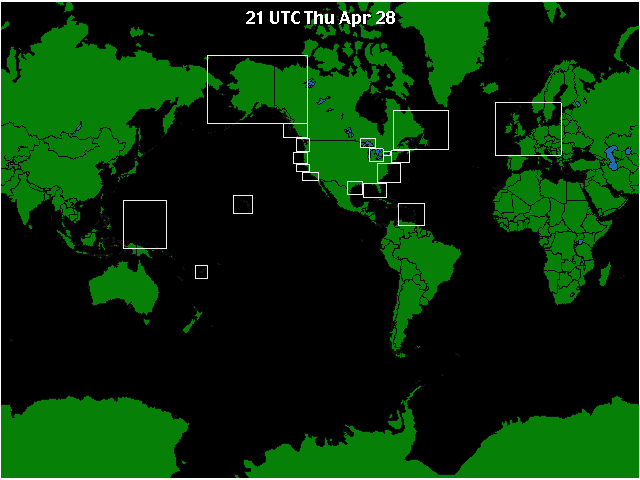
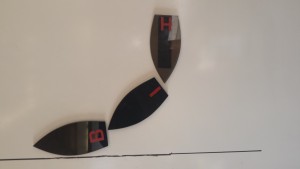
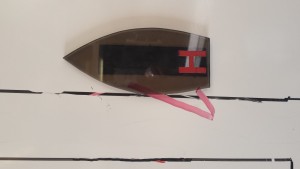
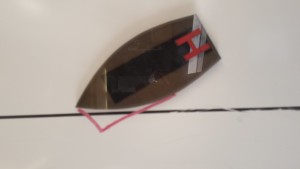
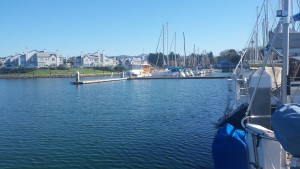 he boat against the dock. Waste cap to starboard? Back in and lay the starboard side against the dock. What could be simpler?
he boat against the dock. Waste cap to starboard? Back in and lay the starboard side against the dock. What could be simpler?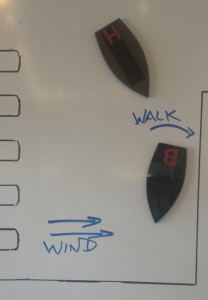 he boat towards the dock. Let it help. Approach at a slight angle to the dock. As you get close, turn slightly away from the dock. Try to end up two or three feet away from the dock with the bow slightly to windward. Assuming port prop walk, when you go into reverse the prop walk will tend to bring the stern towards the dock and the wind will push the bow in. Get a line to the dock fro
he boat towards the dock. Let it help. Approach at a slight angle to the dock. As you get close, turn slightly away from the dock. Try to end up two or three feet away from the dock with the bow slightly to windward. Assuming port prop walk, when you go into reverse the prop walk will tend to bring the stern towards the dock and the wind will push the bow in. Get a line to the dock fro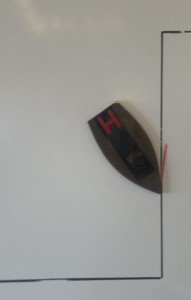 m the stern and you are good. If there is any wind, the bow is held in place from wind pressure.
m the stern and you are good. If there is any wind, the bow is held in place from wind pressure.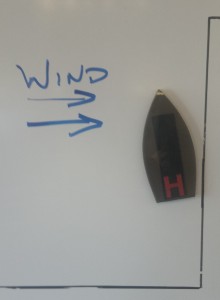 into the dock in reverse is essentially the same. Go into reverse well clear of everything. Back within two to three feet of
into the dock in reverse is essentially the same. Go into reverse well clear of everything. Back within two to three feet of 